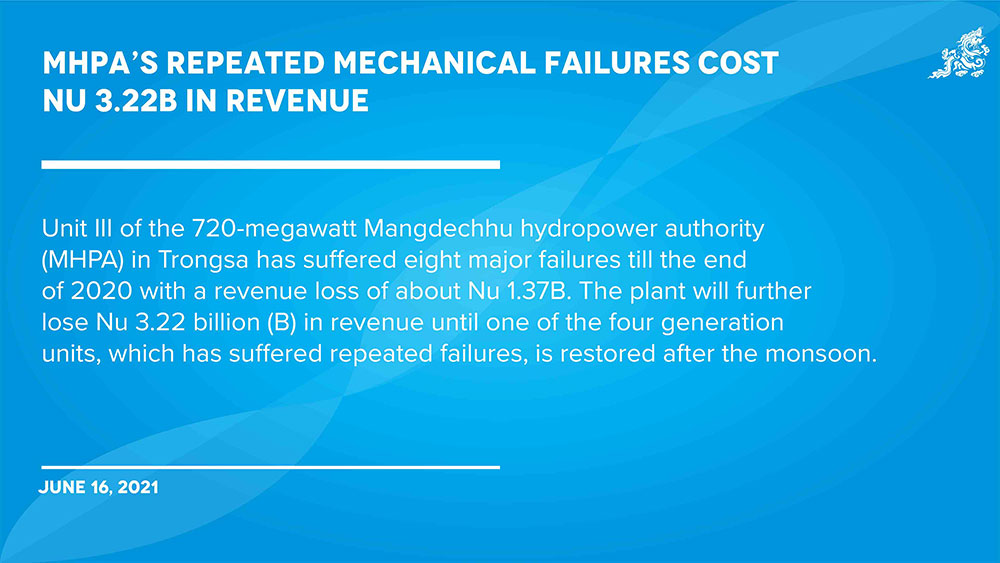The 720-megawatt Mangdechhu hydropower authority (MHPA) in Trongsa will lose Nu 3.22 billion (B) in revenue until one of the four generation units, which has suffered repeated failures, is restored after the monsoon, according to estimates of the finance ministry.
The Unit III of the plant has suffered eight major failures till the end of 2020 with a revenue loss of about Nu 1.37B. The finance ministry in the budget report estimates that the plant will accrue additional revenue loss of about Nu 1.85B in 2021 as the restoration of the defunct unit is likely to be completed only after or during the monsoon.
The issue was discussed in the National Council (NC) yesterday after the finance minister presented the annual budget 2021-22 in the House. Members said the plant also suffered electromechanical issues.
The Unit III remains completely shut. The capacity of each unit is 180 megawatt.
Eminent Member Tashi Wangyal asked when the unit would be restored and whether there were possibilities of claiming compensations from the supplier of the equipment.
Finance Minister Namgay Tshering said that MHPA was able to earn more than enough for repayment of loans despite the mechanical failures. The plant earned Nu 12.9B in the first year when all four units were functioning.
According to the minister, while the annual loss from MHPA was Nu 1.8B, the annual repayment was Nu 4.7B. He said that the first bi-annual repayment and interest payment of Nu 1.392B and Nu 1B respectively, was made on January 22, 2021.
Lyonpo said that equipment had arrived from India and that local engineers would start restoring the unit immediately. He added that an independent committee was formed to study the cause of the failures.
He said that the supplier, Bharat Heavy Electricals Limited (BHEL), an Indian government-owned engineering and manufacturing company, had denied that they supplied defective equipment.
The revised cost of MHPA is Nu 50.732B, of which 70 percent is loan. This means that the total loan portion amounts to Nu 35B, which has to be repaid in 17 years.
The chairperson of the NC’s economic committee, Anand Rai, expressed concerns about the increasing hydropower debts. He asked the minister how the government would repay loans should the export of electricity get affected by unforeseen situations like pandemics.
The finance minister said that the hydropower debts depended on the cost of projects, which normally escalated beyond the original estimates. Citing an example, he said that the cost of Punatsangchhu I had increased from Nu 35B to Nu 94B.
“The cost of hydropower power projects can be higher than GDP,” Lyonpo Namgay Tshering said, adding that the hiring of independent consultants to study alternative solutions to the Punatsangchhu I dam saved about Nu 13B more from being wasted. He said that there was a possibility of barrage being built instead of the dam.
According to Lyonpo, non-hydro debts would be kept below the threshold of 35 percent of the GDP as prescribed by the public debt management policy. He said that the borrowings were invested in productive activities.
The Druk Green Power Corporation was able to generate 11,360.52 MU of electricity in 2020, of which 2,051.350MU was consumed domestically and 9,189.130MU exported to India.
Of the overall gross revenue of Nu 31.048B earned from the sale of energy, Mangdechhu alone earned Nu 12.955B (including billed amount for December 2020).
By MB Subba
Edited by Jigme Wangchuk


